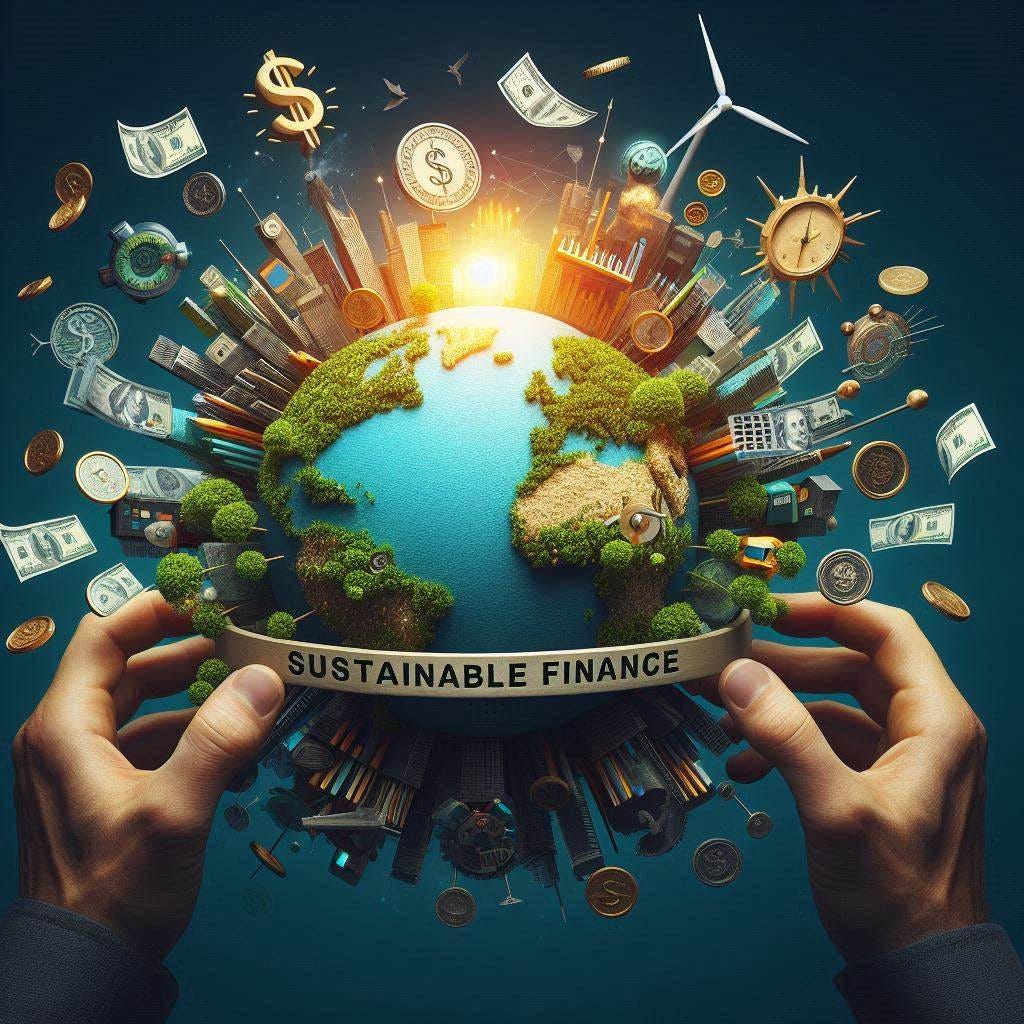
Sustainable Finance: Investing for a Better World – Your Beginner’s Guide to ESG and Impact Investing
In a world grappling with climate change, social inequality, and corporate accountability, how we invest our money has never been more important. Gone are the days when financial decisions were solely about maximizing profit, regardless of the impact. Welcome to the era of Sustainable Finance – where your investments can not only grow your wealth but also contribute to a healthier planet and a more equitable society.
This comprehensive guide will demystify sustainable finance, making it easy for beginners to understand how they can align their money with their values and invest for a better future.
What is Sustainable Finance? More Than Just "Green"
At its core, Sustainable Finance is about making financial decisions that consider environmental, social, and governance (ESG) factors alongside traditional financial returns. It’s about recognizing that a company’s long-term success is deeply intertwined with its impact on the world.
Think of it this way: when you choose to buy products from companies that treat their workers fairly, use renewable energy, or have ethical leadership, you’re voting with your wallet. Sustainable finance applies this same principle to your investments. It’s not just about avoiding "bad" companies; it’s increasingly about actively seeking out "good" ones that are building a sustainable future.
Sustainable finance encompasses several related concepts, often used interchangeably:
- ESG Investing: Focusing on Environmental, Social, and Governance factors.
- Socially Responsible Investing (SRI): Often involves screening out "sin stocks" like tobacco, firearms, or gambling.
- Impact Investing: Directly aiming for measurable positive social or environmental impact alongside financial returns.
- Green Finance: Specifically focusing on environmental projects, like renewable energy or sustainable agriculture.
While these terms have nuances, they all share the common goal of using finance as a force for good.
Why Invest Sustainably? It’s a Win-Win for Your Wallet and the Planet
You might wonder, "Does investing sustainably mean sacrificing returns?" The answer, increasingly supported by research, is a resounding no. In fact, integrating ESG factors can actually lead to better long-term financial performance and reduced risk.
Here’s why investing sustainably is a powerful choice:
1. Make a Real Difference (Positive Impact)
- Tackle Global Challenges: Your money can support companies developing renewable energy, promoting fair labor practices, innovating sustainable agriculture, or providing access to education and healthcare.
- Drive Corporate Change: By investing in companies with strong ESG practices, you encourage others to follow suit. You’re part of a movement pushing for more responsible business behavior.
- Align with Your Values: For many, investing sustainably is about aligning their financial choices with their personal ethics and beliefs. It’s about knowing your money is working for the world you want to see.
2. Financial Resilience and Potentially Stronger Returns
- Reduced Risk: Companies with strong ESG practices often face fewer regulatory fines, litigation, and reputational damage. They tend to be better managed, more adaptable, and less prone to scandals. For example, a company with robust environmental policies is less likely to face penalties for pollution.
- Innovation and Growth: Sustainable companies are often at the forefront of innovation, developing solutions for pressing global problems. This positions them well for future growth in areas like renewable energy, sustainable tech, and ethical consumer goods.
- Long-Term Value Creation: By focusing on factors beyond short-term profits (like employee well-being, resource efficiency, and good governance), these companies are building more resilient and sustainable business models that are better positioned for long-term success.
- Growing Market Demand: More and more investors are seeking sustainable options, driving capital towards these companies and potentially increasing their valuations.
3. Future-Proofing Your Portfolio
- Adapt to Regulation: Governments worldwide are increasingly implementing policies related to climate change, carbon emissions, and social equity. Companies that are already aligned with these trends are better prepared for future regulations and avoid costly transitions.
- Attract Top Talent: Companies with strong social and governance practices are often more attractive to talented employees, leading to a more engaged and productive workforce.
- Consumer Preference: Modern consumers, especially younger generations, are increasingly making purchasing decisions based on a company’s ethical and environmental track record. Sustainable companies are better positioned to capture this growing market.
The Key Pillars of Sustainable Investing: ESG Explained Simply
To understand how sustainable finance works, it’s crucial to grasp the three core pillars: Environmental, Social, and Governance (ESG). These are the non-financial factors that investors use to evaluate a company’s sustainability and ethical impact.
E: Environmental Factors
This pillar assesses a company’s impact on the natural world and its management of environmental risks and opportunities.
- Climate Change:
- Carbon emissions and carbon footprint
- Use of renewable energy vs. fossil fuels
- Strategies for reducing greenhouse gases
- Resource Management:
- Water usage and conservation
- Waste management and recycling efforts
- Sustainable sourcing of raw materials
- Pollution & Biodiversity:
- Air and water pollution prevention
- Impact on local ecosystems and biodiversity
- Management of hazardous waste
Example: An environmentally-focused investor might prefer a utility company investing heavily in solar and wind power over one still reliant on coal.
S: Social Factors
This pillar examines a company’s relationship with its employees, customers, suppliers, and the broader community.
- Labor Practices:
- Fair wages and benefits
- Worker safety and health
- Employee diversity and inclusion
- Labor relations and union rights
- Product Safety & Quality:
- Ethical product development and marketing
- Customer data privacy and security
- Supply chain transparency and ethical sourcing (e.g., no child labor)
- Community Engagement:
- Community development initiatives
- Human rights considerations
- Impact on local populations
Example: A socially-focused investor might choose a clothing brand known for fair wages and safe working conditions in its factories over one with a history of sweatshop labor.
G: Governance Factors
This pillar looks at how a company is led, its internal controls, and its ethical practices. It’s about transparency, accountability, and leadership that serves the long-term interests of all stakeholders.
- Board Diversity & Structure:
- Independence of board members
- Diversity in gender, background, and experience
- Executive compensation practices
- Business Ethics:
- Anti-corruption and anti-bribery policies
- Tax transparency
- Whistleblower protection
- Shareholder Rights:
- Fair treatment of all shareholders
- Transparency in financial reporting
- Auditing practices
Example: An investor focused on governance might avoid a company with a history of executive scandals, excessive CEO pay, or a board made up entirely of insiders.
How to Invest Sustainably: Your Options
Sustainable finance isn’t just for institutional investors; individuals like you can easily participate. Here are some common ways to get started:
1. ESG Funds and ETFs
- What they are: These are collections (baskets) of stocks or bonds chosen specifically because they meet certain ESG criteria.
- How they work: Fund managers research and select companies that score well on ESG metrics, or they might exclude companies involved in controversial industries (like tobacco or fossil fuels).
- Why they’re popular: They offer diversification (spreading your money across many companies) and professional management, making it easy for beginners. You can find ESG-focused mutual funds or exchange-traded funds (ETFs) through most investment platforms.
2. Green Bonds and Social Bonds
- What they are: These are fixed-income investments (like a loan you give to an entity) where the money raised is specifically earmarked for environmental (green) or social (social) projects.
- How they work: When you buy a green bond issued by a company, government, or international organization, your money goes directly towards projects like renewable energy plants, sustainable infrastructure, or affordable housing. You get your principal back plus interest, just like a regular bond.
- Why they’re unique: They offer a direct link between your investment and a specific positive outcome.
3. Impact Investing
- What it is: This is a more direct form of investing with the explicit goal of generating measurable social or environmental impact alongside a financial return.
- How it works: Impact investments can range from investing directly in a small startup addressing a specific social need (e.g., clean water technology in developing countries) to larger funds focused on specific impact themes.
- Why it’s distinct: While ESG investing often focuses on risk mitigation and better-run companies, impact investing is more about intentionality and measurable positive outcomes. It can sometimes involve higher risk or less liquidity (ease of selling your investment) than traditional options.
4. Shareholder Engagement
- What it is: If you own shares in a company, you have the right to vote on certain company matters. Shareholder engagement involves using this right to push for more sustainable practices.
- How it works: This can be done by voting your proxy shares (often through your investment platform) on proposals related to climate change, diversity, or executive pay. Larger institutional investors often engage directly with company management.
- Why it matters: Even as a small individual investor, your vote, combined with others, can influence corporate behavior.
Common Myths About Sustainable Investing Debunked
Many people still hold misconceptions about sustainable finance. Let’s clear them up!
- Myth #1: Sustainable Investing Means Lower Returns.
- Reality: This is the most common myth. Numerous studies and real-world performance data show that ESG-integrated portfolios often perform as well as or even better than traditional investments over the long term. Companies with strong ESG practices are often better managed and more resilient.
- Myth #2: It’s Only for the Wealthy or Institutional Investors.
- Reality: Not at all! With the proliferation of ESG mutual funds and ETFs available on standard brokerage platforms, anyone can start investing sustainably with relatively small amounts of money.
- Myth #3: It’s Too Complicated to Understand.
- Reality: While the underlying research can be complex, accessing sustainable investments is now as easy as buying any other fund or ETF. Your financial advisor can also guide you.
- Myth #4: It’s Just a Passing Fad.
- Reality: Sustainable finance is a growing, irreversible trend driven by increasing investor demand, regulatory changes, and a global recognition of environmental and social challenges. It’s becoming mainstream.
- Myth #5: It’s Just "Greenwashing" (Companies Pretending to be Sustainable).
- Reality: While "greenwashing" is a valid concern, the sustainable finance industry is rapidly developing better standards, data, and regulations to ensure transparency and accountability. Reputable ESG funds use rigorous research to identify truly sustainable companies. Do your research and look for funds with clear methodologies.
How to Get Started with Sustainable Investing
Ready to align your money with your values? Here’s a simple roadmap:
- Define Your Values: What environmental or social issues are most important to you? Climate change? Human rights? Fair labor? This will help you narrow down your focus.
- Do Your Research:
- Look for reputable investment platforms that offer ESG funds and ETFs.
- Many platforms provide filters to search for sustainable options.
- Read the fund’s prospectus or summary to understand its specific ESG criteria and what companies it invests in (and avoids).
- Look for independent ESG ratings from organizations like MSCI, Sustainalytics, or S&P Global.
- Talk to a Financial Advisor: If you have complex financial needs or want personalized guidance, seek out a financial advisor who specializes in sustainable investing. They can help you create a portfolio tailored to your goals and values.
- Start Small: You don’t need a huge sum to begin. Many funds allow for small initial investments or regular contributions.
- Monitor and Adjust: As with any investment, regularly review your sustainable portfolio’s performance and ensure it still aligns with your evolving values and financial goals.
The Future of Sustainable Finance: A Force for Good
Sustainable finance is no longer a niche market; it’s a rapidly expanding and increasingly mainstream approach to investing. As awareness of global challenges grows and investors demand more from their money, the flow of capital towards sustainable solutions will only accelerate.
By choosing to invest sustainably, you’re not just making a smart financial decision; you’re becoming an active participant in building a more resilient, equitable, and sustainable world for generations to come. Your money has power – use it to make a difference.



Post Comment